ASRock Z77 Extreme6 Review: Legacy Bites Back
by Ian Cutress on July 13, 2012 2:00 PM EST- Posted in
- Motherboards
- ASRock
- Z77
A note about 3-way AMD
So far most of the Z77 motherboards we have tested had three full length PCIe slots - two from the CPU that can be x16/- or x8/x8, and a third that was limited to 4 PCIe 2.0 lanes from the chipset. By design, this final third slot should not be graphics compatible - with only four PCIe 2.0 lanes from the chipset, it would be slow as well.
ASRock bucks the trend with the Z77 Extreme6, and allows this third PCIe slot to accept a GPU:
Even though the Extreme6 is the only board we have tested tri-GPU so far, we will add the results here for completeness. Unfortunately, we only have three AMD GPUs, and were unable to test three NVIDIA GPUs.
Civilization V
Civilization V is a strategy video game that utilizes a significant number of the latest GPU features and software advances. Using the in-game benchmark, we run Civilization V at 2560x1440 with full graphical settings, similar to Ryan in his GPU testing functionality. Results reported by the benchmark are the total number of frames in sixty seconds, which we normalize to frames per second.
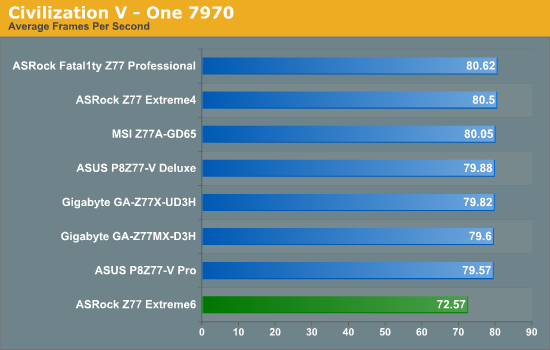
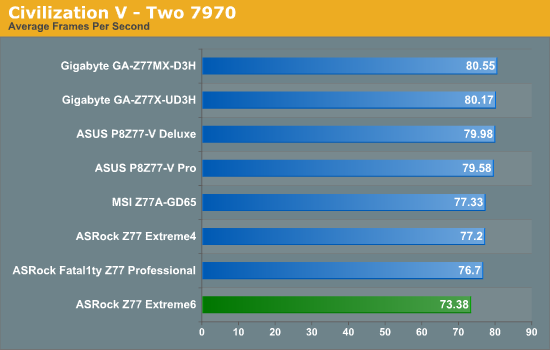
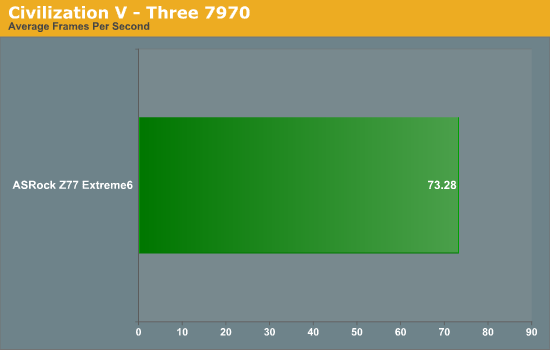
Strangely on Civilization V, the ASRock Z77 Extreme6 seems to not enjoy processing frames, coming bottom on both single and dual 7970 by a significant margin. However, the board is the only Z77 we have tested that will happily accept three GPUs.
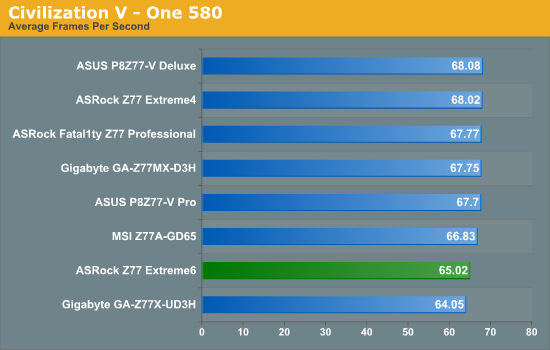
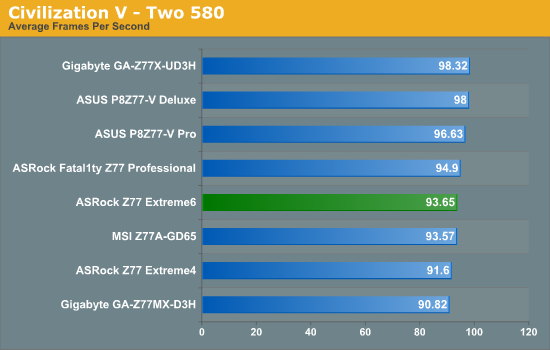
Again, with NVIDIA the board does not perform that well, especially when the other ASRock motherboards we have tested are reasonable.
Dirt 3
Dirt 3 is a rallying video game and the third in the Dirt series of the Colin McRae Rally series, developed and published by Codemasters. Using the in game benchmark, Dirt 3 is run at 2560x1440 with full graphical settings. Results are reported as the average frame rate across four runs.
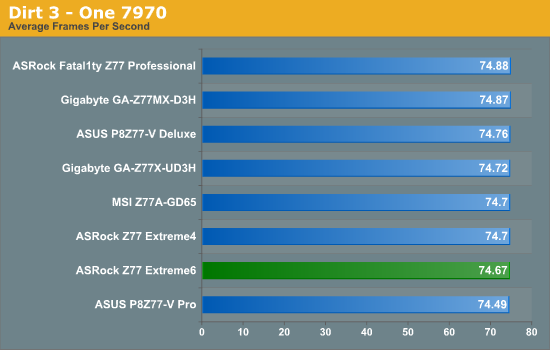
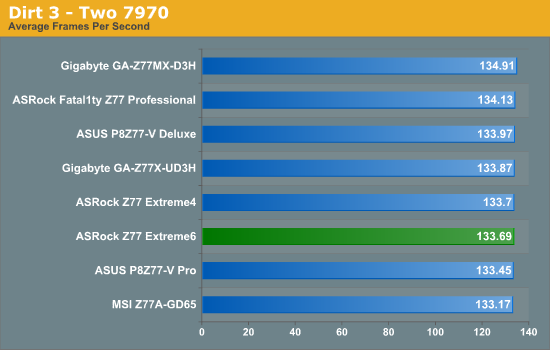
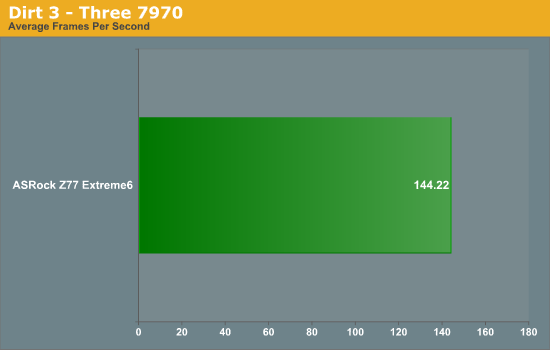
The ASRock Z77 Extreme6 does not light up the charts with Dirt3, but the differences between first and last are very small. It is interesting to note that the first GPU gives 74.67 FPS, the second GPU adds 59 FPS, and the third only adds 11 FPS. This is most likely due to the third GPU being limited to 4 PCIe 2.0 lanes.
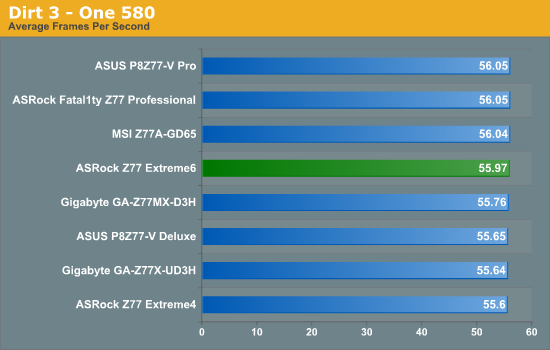
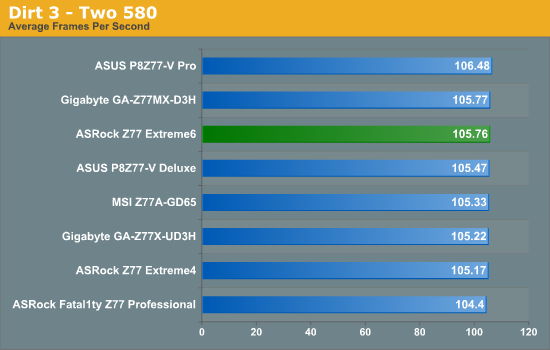
NVIDIA wise, the Extreme6 puts up more of a battle and ends up mid table, where less than 2 FPS separates first and last in dual GPU and 0.4 FPS for single GPU.
Metro2033
Metro2033 is a DX11 benchmark that challenges every system that tries to run it at any high-end settings. Developed by 4A Games and released in March 2010, we use the inbuilt DirectX 11 Frontline benchmark to test the hardware at 2560x1440 with full graphical settings. Results are given as the average frame rate from 4 runs.
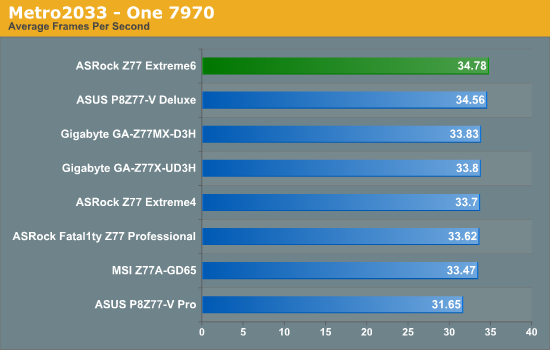


Surprisingly the Extreme6 does take the lead on one gaming benchmark - Metro2033 using a single 7970.
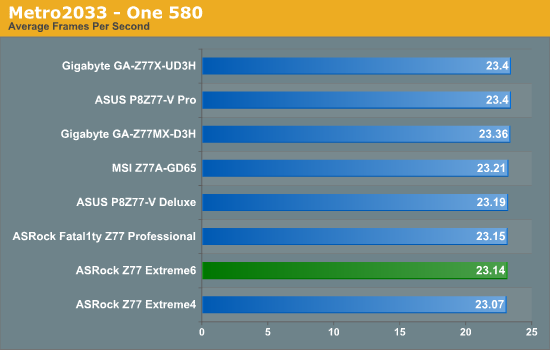
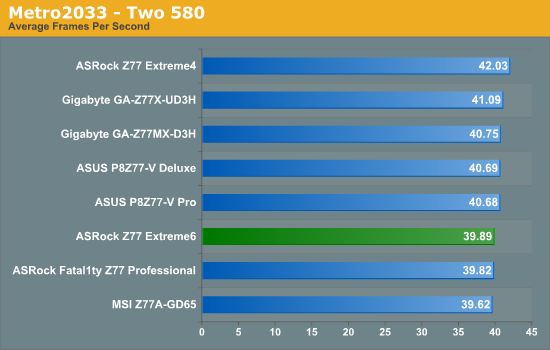











35 Comments
View All Comments
nubie - Saturday, July 14, 2012 - link
Yes, a COM port and Serial port are generally the same thing.I much prefer Parallel, because I am "bit-banging" to program an Atmega micro-controller, a I2C EEPROM, or an SPI EEPROM.
Although I do have a couple Packard Bell Fast Media Infrared (FMIR) receivers that demand a COM port, as does the (sadly lacking drivers newer than Win98) 6-axis Spacetec Orb controller.
Meaker10 - Saturday, July 14, 2012 - link
Without looking at the specs the mini slot is pci-e (for wifi) as it is half height and msata slots need to be full height.repoman27 - Saturday, July 14, 2012 - link
I thought one of the features of the Z77 chipset was that you could select between 1 x16, 2 x8, or 1 x8 + 2 x4 for the PCIe 3.0 lanes coming off of the CPU? In which case you wouldn't need an additional PCIe switch and all three cards would get at least 32 Gbps of PCIe bandwidth...Also, Ian, you seem to have some persistent dyslexia going on when it comes to the model names of PLX's PCIe switches; it's "PEX 8747", not "PXE 8747". There are other options available as well, such as the smaller, cheaper PEX 8724, which would have allowed them to offer effectively 3 x8 PCIe 3.0 slots.
scott967a - Saturday, July 14, 2012 - link
Do you guys ever test wake on lan or other wake up functions? Reason being for the first time I thought I would set up an old sys using Abit P35 Pro for WoL with fail result. Not sure if it is operator error or MB/BIOS problem but searching online doesn't yield much info on WoL performance.529th - Sunday, July 15, 2012 - link
Thank you for including a DPC latency test. Thank you Thank you Thank you! ha...Which app are you using to check DPC latency, btw?
Please include DCP latency testings in your future Motherboard testings as well. I will be jumping on the Haswell wagon when it comes through town.
Cheers
529th - Sunday, July 15, 2012 - link
And also include the BIOS that it's being tested on. Thanks :)IanCutress - Sunday, July 15, 2012 - link
As you can perhaps tell from our DPC Graph, we've been testing it quite a while. And in the explanation of said test, I do mention the program I use - DPC Latency Checker. Quick Google will find it. Currently I'm rarely finding a motherboard on a mainstream chipset that severely fails it - usually it is the included monitoring software that causes peaks of 2000+. If this happens, disable your monitoring software or update the BIOS.Ian
hansmuff - Sunday, July 15, 2012 - link
If I were to release a legacy connector board, I would most certainly at the very least have two serial ports in the back, or one plus header. I would also most certainly include a parallel port header on the motherboard, and include brackets for serial and parallel headers.Floppy and IDE is all good and well, but one serial port and no parallel port are oversights to me for such a board.
adrianlegg - Monday, July 16, 2012 - link
Hello,I just had some random idea,
Couldn't You use, some kind of electric stopwatch, which can be started/paused with any current, connect it to poweron wire (from button), and then instead of using Windows, use some custom linux bootloader with option to, for example, use pc speaker, which signal would be used to stop mobo?
I lack proper knowledge to design that system, aside from components (2 wires, custom bootloader, and stopwatch/some multimeter with time option)
Excuse me if that's completely ignorant, but I think that could increase precision of Your timings.
Thx for all good work.
adrianlegg - Monday, July 16, 2012 - link
(ofc not "stop mobo" but "stop timing")